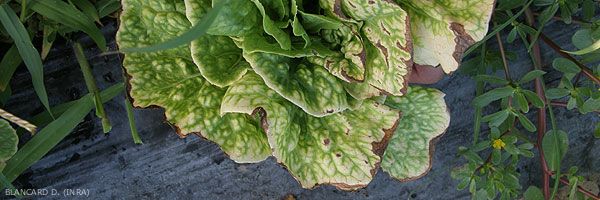
Beet pseudo-yellows virus (BPYV)
Beet pseudo-jaundice virus
- classification : Closteroviridae, Closterovirus
The beet pseudo-jaundice virus ( Beet pseudo-yellows virus , BPYV) causes damage to salads, mainly under shelter. It is probably hosted by other plant species. Isolated in the United States in an experimental greenhouse, the virus has long been considered in this country as anecdotal; in fact, greenhouse lettuce crops are negligible. Subsequently, it has been observed in France, the Netherlands, the Czech Republic, Italy and Turkey. It is probable that this virus is rife throughout the Mediterranean Basin. It is also present in Asia and Australia.
Although its symptoms on lettuce are relatively characteristic, it is undeniable that the yellowing it causes on this plant, as on other susceptible cultivated species, has been wrongly attributed to nutritional disorders. In this situation and / or in the absence of diagnostic tools, the effects of this virus have certainly been underestimated in certain production areas.
In France, as in the Netherlands, BPYV caused very significant damage to lettuce crops under cover, as long as it was not possible to implement prophylactic measures adapted to its biology and its disease. epidemiology. Currently, the impact of this virus on salads has decreased considerably. The most serious outbreaks occur in cases of lettuce / cucumber rotations. The latter host is very susceptible to both greenhouse whitefly and virus; significant losses are sometimes observed as a result of such rotations.
In Spain, its real impact is difficult to assess compared to other "clostero-like" and Criniviruses responsible for yellows in lettuce, such as cucurbits. On this last family, it is considered today as a serious virus in the United States and in Asia.
Its wide host range and the difficulty of controlling its vector, which ranges from one culture to another, make it a high-risk virus, especially on salads.
 |
| Figure 1 |
BPYV is currently located in the Closterovirus or “clostero-like” genus (Figure 1); but further molecular studies could locate it in the genus Crinivirus. Although it was first isolated in 1965, it is still incompletely characterized. Located in phloem cells, BPYV is not mechanically transmissible. It is very difficult to purify and routine diagnostic tools are still currently unavailable. It is now well accepted that viruses previously described as Cucumber yellows virus, Muskmelon yellows virus, Melon yellows virus, Cucumber infectious chlorosis virus and Cucumber chlorotic spot virus were, in fact, isolates or strains of BPYV.





